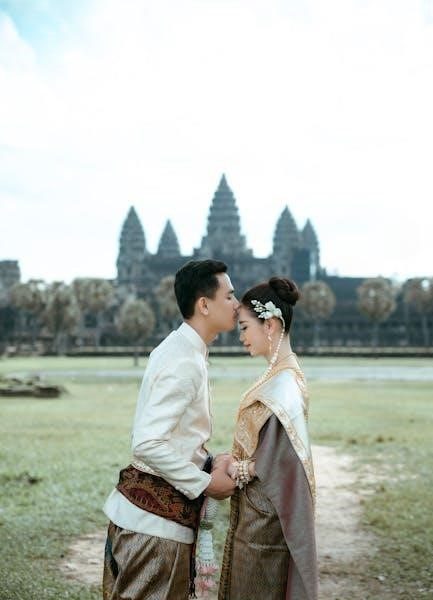
lotf pdf
William Golding’s Lord of the Flies, published in 1954, explores human nature through a group of boys stranded on a deserted island. The novel delves into themes of savagery, civilization, and leadership, offering a gripping narrative of survival and moral decay. Available as a PDF, it remains a timeless classic for readers worldwide.
1.1 Overview of the Novel
Lord of the Flies, written by William Golding and published in 1954, is a thought-provoking novel that explores the darker aspects of human nature. The story revolves around a group of British boys stranded on a deserted island after a plane crash, with no adult supervision. Initially, the boys attempt to create a utopian society, electing Ralph as their leader and establishing rules to maintain order. However, as time progresses, their civilized behavior erodes, and primal instincts take over, leading to chaos and violence.
The novel is divided into chapters, each detailing the boys’ descent into savagery. Key events include the hunt for pigs, the emergence of the “beast” as a symbol of fear, and the eventual division of the group into rival factions led by Ralph and Jack. Golding’s vivid descriptions of the island’s environment and the boys’ actions create a gripping narrative that examines themes of power, morality, and the effects of isolation.
Recent editions of the novel, including the PDF version, feature a new foreword by Lois Lowry and suggestions for further reading by Jennifer Buehler, enhancing its accessibility for modern readers. The story’s timeless relevance has also sparked discussions about adaptations, such as an all-female version, which has garnered mixed reactions. Despite these reinterpretations, Golding’s original work remains a powerful exploration of humanity’s duality, making it a classic for readers of all ages.
1.2 Historical Context and Background
Lord of the Flies, written by William Golding in 1954, is deeply rooted in the historical and cultural context of its time. The novel was published in the aftermath of World War II, a period marked by global upheaval and a heightened awareness of humanity’s capacity for violence. Golding, who served in the Royal Navy during the war, was profoundly influenced by the atrocities he witnessed, which shaped his pessimistic view of human nature. The novel reflects the Cold War era’s anxieties about societal breakdown and the inherent flaws in human behavior.
Golding drew inspiration from earlier works, such as Robert Ballantyne’s Coral Island, but offered a darker, more realistic portrayal of stranded children. His teaching career also informed his understanding of adolescent behavior, which he used to craft the characters’ dynamics. The novel’s exploration of ethics and morality aligns with philosophical debates of the time, particularly those influenced by thinkers like Emmanuel Kant.
The PDF version of Lord of the Flies has made the novel more accessible to modern readers, ensuring its themes of savagery, leadership, and societal collapse remain relevant. Golding’s background and the historical context of the post-war era provide a rich foundation for understanding the novel’s enduring significance. His work continues to provoke thought about humanity’s duality, making it a timeless classic for scholars and readers alike.

Major Themes in Lord of the Flies
Lord of the Flies explores themes of savagery vs. civilization, ethics, and leadership dynamics. The novel portrays boys descending into chaos, revealing humanity’s darker instincts. Available as a PDF, it examines moral decay, power struggles, and the loss of innocence, offering profound insights into human nature.
2.1 Savagery vs. Civilization

In Lord of the Flies, William Golding explores the inherent conflict between savagery and civilization through the boys’ behavior on the island. Initially, the boys attempt to create a structured, civilized society, symbolized by the conch shell, which represents order and democracy. However, as the novel progresses, their primal instincts emerge, leading to chaos and violence.
The descent into savagery is marked by the boys’ obsession with hunting and their fear of the “beast,” a symbol of their collective anxieties. The character of Jack Merridew embodies this shift, as he becomes increasingly consumed by his desire for power and control, abandoning civilized norms. In contrast, Ralph’s efforts to maintain order and rescue highlight the struggle to preserve civilization.
Golding uses the island as a microcosm of society, revealing how quickly human beings can revert to primitive behavior when external constraints are removed. The novel suggests that savagery is an inherent part of human nature, suppressed only by the rules and structures of civilization. This theme is central to the novel’s exploration of human morality and the effects of isolation.
The PDF version of Lord of the Flies allows readers to delve into this timeless exploration of human nature, offering a gripping narrative that challenges readers to reflect on their own capacity for savagery and civilization.
2.2 Ethics and Morality in Society
Lord of the Flies by William Golding is a profound exploration of ethics and morality, set against the backdrop of a group of boys stranded on a deserted island. The novel examines how the absence of adult supervision leads to a gradual erosion of moral values, revealing the darker aspects of human nature. Through the boys’ actions, Golding critiques the notion of inherent morality, suggesting that ethical behavior is often a product of societal constraints rather than innate goodness.
The character of Ralph represents the voice of reason and moral integrity, advocating for fairness and justice. In contrast, Jack Merridew’s descent into authoritarianism and violence highlights the dangers of unchecked ambition and the collapse of ethical standards. The novel also explores the concept of collective guilt, as the boys’ fear of the “beast” symbolizes their deep-seated anxieties and moral failings.
Golding’s portrayal of the boys’ society challenges the idea of progress and civilization, suggesting that moral decay is inevitable when individuals prioritize power over ethics. The PDF version of the novel provides a detailed analysis of these themes, offering readers a deeper understanding of how societal norms shape human behavior. Ultimately, Lord of the Flies serves as a cautionary tale about the fragility of morality and the importance of ethical leadership in maintaining social order.
2.3 Leadership and Power Dynamics

Lord of the Flies by William Golding delves deeply into the complexities of leadership and power dynamics, illustrating how these forces shape human behavior in the absence of societal structures. The novel presents two contrasting leaders: Ralph, who embodies democratic ideals, and Jack Merridew, who adopts an authoritarian approach. Ralph’s leadership is characterized by a commitment to fairness, order, and the greater good, as seen in his emphasis on building shelters and maintaining the signal fire. In contrast, Jack’s leadership is driven by a desire for power and control, often prioritizing hunting and immediate gratification over collective well-being.
The struggle for dominance between Ralph and Jack serves as a microcosm for broader societal conflicts. Ralph’s reliance on the conch shell as a symbol of democracy highlights the importance of shared voice and consensus, while Jack’s manipulation of fear and superstition underscores the dangers of authoritarianism. The novel also explores how power shifts influence group dynamics, as characters like Piggy, who possesses intellectual authority, are marginalized due to their lack of physical strength or charisma.
The PDF version of the novel provides a detailed examination of these power struggles, revealing how leadership styles reflect deeper human tendencies. Golding’s portrayal of leadership and power dynamics serves as a cautionary tale, emphasizing the importance of ethical guidance in maintaining social harmony and preventing chaos.

Main Characters in Lord of the Flies

The novel introduces key characters like Ralph, Jack, Piggy, and Simon, each representing distinct traits. Ralph embodies leadership, Jack symbolizes power, Piggy offers wisdom, and Simon provides introspection. These characters drive the story, exploring themes of humanity and society. The PDF highlights their roles in Golding’s timeless tale.
3.1 Ralph: The Democratic Leader
Ralph, the protagonist of Lord of the Flies, is a fair-minded and idealistic boy who represents democracy and order. Elected as the leader, he strives to maintain civility and organize the group to achieve common goals, such as building shelters and starting fires. His leadership is characterized by a desire to ensure everyone’s voice is heard, symbolized by the conch shell, which he uses to maintain order during meetings.
Despite his good intentions, Ralph faces challenges as the group’s behavior deteriorates. His inability to control the boys’ primal instincts and their fear of the “beast” leads to internal conflicts. Ralph’s leadership is contrasted with Jack’s authoritarian style, highlighting the tension between democracy and dictatorship. Throughout the novel, Ralph’s character evolves, revealing his growth from innocence to a deeper understanding of human nature.
Ralph’s eventual realization of the true nature of humanity marks a significant turning point in the story. His journey from optimism to disillusionment underscores Golding’s exploration of civilization’s fragility. The PDF version of the novel provides a detailed account of Ralph’s struggles and his ultimate acceptance of the darkness within human hearts, making him a compelling and complex character.

3.2 Jack Merridew: The Hunter and Rival Leader

Jack Merridew, a central character in Lord of the Flies, begins as a dedicated hunter but evolves into a power-hungry rival leader. Initially, Jack’s focus is on providing food for the group, showcasing his responsibility and determination. However, his obsession with hunting gradually overtakes his sense of duty, leading him to prioritize power over the well-being of others.
Jack’s charisma and assertiveness make him a natural leader, but his desire for control drives him to challenge Ralph’s authority. He eventually forms his own tribe, symbolizing the rise of savagery over civilization. Jack’s leadership is marked by fear and intimidation, as he enforces loyalty through violence and manipulation. His actions, such as stealing pigs and raiding Ralph’s group, highlight his descent into brutality.
Jack’s transformation reflects Golding’s exploration of humanity’s darker instincts. His refusal to acknowledge the true nature of the “beast” and his focus on hunting symbolize his rejection of reason and morality. By the novel’s end, Jack’s tribe hunts Ralph, illustrating the complete collapse of civility. The PDF version of the novel provides a detailed account of Jack’s evolution, revealing his role as a catalyst for chaos and the embodiment of primal human instincts. His character serves as a stark contrast to Ralph’s democratic ideals, underscoring the novel’s themes of power and savagery.

3.3 Piggy: The Voice of Reason
Piggy, one of the most intelligent and rational characters in Lord of the Flies, serves as the moral compass of the group. Despite his physical limitations—he is overweight and suffers from asthma—Piggy consistently advocates for logic, order, and civility. His glasses, which are crucial for starting fires, symbolize his practical wisdom and the group’s reliance on his intellect.
Piggy’s role as the voice of reason is evident in his efforts to maintain democratic practices, such as using the conch shell to ensure everyone’s voice is heard. He often challenges Jack’s impulsive decisions and Ralph’s indecisiveness, urging the group to focus on building shelters and creating a signal fire. However, his ideas are frequently dismissed due to his unimposing appearance and lack of charisma.
Throughout the novel, Piggy’s character represents the fragile nature of intellect and morality in the face of primal instincts. His tragic death, caused by Roger’s deliberate act of violence, marks the complete collapse of civility on the island. The PDF version of the novel highlights Piggy’s significance as a symbol of reason and enlightenment, making his loss a poignant reminder of humanity’s capacity for destruction. His legacy endures as a testament to the importance of wisdom and compassion in a world prone to chaos.
3.4 Simon: The Innocent and Introspective

Simon, a quiet and introspective character in Lord of the Flies, embodies innocence and wisdom beyond his years. Unlike the other boys, Simon is physically frail and often overlooked, but his deep understanding of human nature and the island’s secrets sets him apart. He spends much of his time alone, exploring the island and contemplating its mysteries.
Simon’s most significant contribution to the group is his discovery of the “beast,” which he realizes is not a monster but a dead pilot whose body has been rotting on the island. This revelation symbolizes the true nature of fear and savagery, highlighting that the greatest threat lies within the boys themselves. However, his attempt to share this truth is met with violence, as he is killed by the group in a frenzied attack during a ritual dance.
Simon’s death marks a turning point in the novel, as it signifies the complete erosion of innocence and the dominance of primal instincts. His character serves as a moral guide, offering insights into the duality of human nature. The PDF version of the novel underscores Simon’s role as a prophet-like figure, whose untimely death leaves the group devoid of rationality and compassion. His legacy remains a poignant reminder of the fragility of goodness in the face of chaos.
Literary Devices and Style
William Golding’s Lord of the Flies is renowned for its masterful use of literary devices, which enhance the novel’s exploration of human nature. One of the most prominent techniques is symbolism, particularly through the conch shell, which represents order and democracy, and the “beast,” symbolizing fear and the unknown. The island itself serves as a microcosm of society, allowing Golding to examine how humanity descends into chaos when stripped of civilization.
Golding also employs imagery to create vivid contrasts, such as the island’s initial beauty and its eventual degradation. The scar left by the plane crash and the boys’ gradual dishevelment mirror their internal moral decay. Additionally, the novel uses foreshadowing effectively, as seen in Simon’s eerie encounter with the pig’s head and his eventual death, which hints at the group’s escalating savagery.
The author’s style is both concise and evocative, with a focus on psychological depth. His use of irony is evident in the boys’ belief in a mythical “beast,” while the true horror lies within themselves. The PDF version of the novel retains these literary elements, ensuring readers can fully appreciate Golding’s craftsmanship. Through these devices, Golding crafts a compelling narrative that probes the darker aspects of human behavior, making Lord of the Flies a timeless classic.
Related Posts

house tree person interpretation free pdf
Discover the deep symbolism behind house, tree, and person interpretations. Get your free PDF guide now and uncover the secrets!
gingerbread house coloring pages pdf
Download free gingerbread house coloring pages in PDF! Perfect for kids and adults, these festive designs bring holiday cheer. Print and color now!

quartet intermediate japanese pdf free
Enhance your Japanese skills with our free Quartet Intermediate Japanese PDF. Perfect for learners seeking to improve their language proficiency. Download now and take your Japanese to the next level!